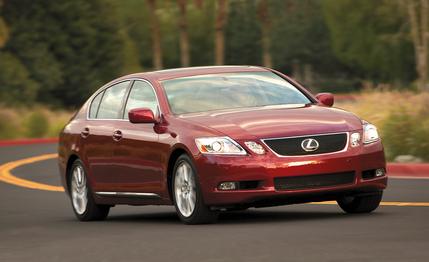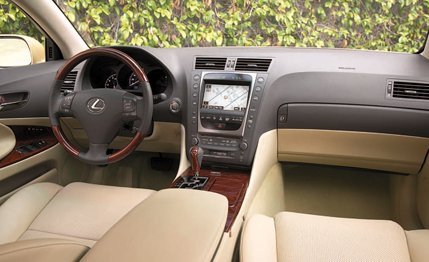
 First Drive Review
First Drive Review


Chief engineer Shigetoshi Miyoshi invoked the "p" word—"passion"—frequently in his preview presentation for the third-generation Lexus GS series, but after a short day of mountain-road driving around Palm Springs, we're not convinced it's the word that really captures the essence of these new sedans.
How about "sophisticated"? Hard to dispute that as a descriptor. The inventory of electromechanical enhancements—VVT-i, AVS, EPS, VGRS, EBD, TPM, AFS, VDIM—rivals the alphabetical agencies of the Roosevelt administration. These babies—the GS300 and the GS430—are nothing if not trick. Particularly the GS430.
Stylish would also seem to apply. So would smooth, quiet, tasteful, and hedonistic. But even though the GS430 is, according to division manager Denny Clements, "the fastest Lexus ever built," it doesn't seem to be the kind of car we associate with red mist and seeking out the long way home. As luxoid sports sedans go, its message seems more attuned to the cerebrum than to the viscera.
We'll see the GS430 in more detail next month. For this report, we'll cover the GS300, which is offered in rear- and all-wheel drive, a first for a Lexus passenger car, and thus our focus here.


So let's examine what Lexus hath wrought. The last GS makeover was for the 1998 model year, which is ancient in terms of design shelf life today. So it's good that the new GS really is new—new body shell, new styling, new technology, new just about everything, with the exception of the GS430's 4.3-liter V-8, which is shared with the flagship LS430 sedan. The new GS is a slightly bigger car than the previous version, although the biggest dimensional change—a 2.0-inch wheelbase stretch, to 112.2 inches—is hard to see, as is the wider (by 1.2 inches) rear track. The beam has broadened from 70.9 inches to 71.7, and overall length has increased fractionally, from 189.2 to 190.0 inches. The roofline has come up slightly, from 55.9 to 56.1 inches (56.5 for the all-wheel-drive model), and Lexus is attempting to make a virtue of increased front overhang, which allows a "simpler, rounder, and more sculpted profile," according to Miyoshi.
Another distinct break with this car's Giugiaro-inspired past is a distinctly higher beltline, which, again quoting Miyoshi, "is more stylish, more formal, and conveys a more serious presence." The net result, says Lexus, is "a major departure from the norm," which works—provided your GS isn't parked next to a new Mercedes CLS.